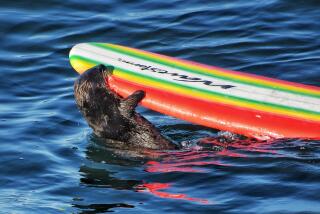Alaska’s Sea Otters May Join the Endangered Species List
- Share via
Southwest Alaska’s sea otters, which have undergone dramatic and mysterious declines in recent years, will receive Endangered Species Act protection under an Interior Department proposal announced Thursday.
Interior Secretary Gale A. Norton said scientists were not yet certain what was driving the sea otters around the Aleutian Islands toward extinction. “But,” she said, “listing this population as ‘threatened’ under the Endangered Species Act will be an important step in discovering the reasons and reversing the decline.”
Once the proposed regulation is final, Alaska’s otters would become the 22nd species added to the endangered list under the Bush administration. The Center for Biological Diversity, based in Arizona, petitioned the U.S. Fish and Wildlife Service to list the otters in 2000, and in December, two animal welfare groups sued, seeking to force a listing decision.
The otters included in the proposal inhabit a vast part of Alaska -- a shoreline roughly equivalent to the entire Eastern seaboard.
Southwest Alaska’s ocean ecosystem has collapsed in the last decade, scientists say. A variety of once-abundant sea mammals has nearly disappeared. Scientists conducting sea otter surveys around the Aleutians 10 years ago used to see the coastline brimming with the furry creatures.
Now those same shores are virtually empty of mammals, with scientists counting only a few otters per mile.
Alaska’s sea otters were nearly driven to extinction a century ago by commercial fur hunters, but the population rebounded after hunting was banned in 1911. By the 1980s, the region was again a stronghold for otters, its thick kelp forests home to more than half of the world’s population.
But since then, their numbers have dropped by an average of about two-thirds. The most severe decline is around the Aleutians, where only about 9,000 otters remain -- nearly a 90% reduction.
“Precipitous declines in sea otter populations in southwest Alaska constitute the most significant conservation issue for the northern sea otter since commercial fur trades,” the U.S. Fish and Wildlife Service reported.
A group of scientists, led by James Estes of the U.S. Geological Survey, has theorized that the otters are being eaten by killer whales.
Although otters offer little sustenance for a killer whale, Estes believes they switched diets because their usual prey -- bowhead, humpback and other whales -- was depleted by commercial whalers a half-century ago. Estes’ team, which has been surveying the Aleutians’ otters for 35 years, has seen killer whales attack otters in recent years.
Douglas Burn, a biologist who leads the wildlife service’s sea otter program in Alaska, said other forces -- man-made or natural -- could be involved too.
Because of the region’s remoteness and the complexity of its food web, Burn said that unraveling the cause -- or causes -- of the disappearing otters will be particularly difficult.
“It’s safe to say that there is not going to be an easy answer, no ‘Eureka, this is it’ moment,” Burn said.
So far, there is no evidence that pollution, starvation or disease has harmed the otters. But research has focused on only one part of the massive region, and work is needed in more remote areas, Burn said.
The proposal will undergo a year of review, including public hearings. Once a species is listed, the federal government must develop a recovery plan that restricts activities that jeopardize its existence.
The fish and wildlife agency cannot say yet what its recovery plan will entail and has not designated which habitat areas are essential to recovery. Burn said the agency would work with Alaska to come up with protections.
The listing is unlikely to affect Alaska’s multibillion-dollar commercial fishing industry because otters eat sea urchins, not fish, so there is no competition. Fisheries there already are regulated to protect the endangered Steller sea lion.
“The amount of interaction between the fishing industry and the sea otters is extremely minimal,” Burn said.
The southern population of sea otters, inhabiting Central California waters, has been protected as a threatened species since 1977.
Two other Alaska populations are considered stable and are not included in the proposed rule.
More to Read
Sign up for Essential California
The most important California stories and recommendations in your inbox every morning.
You may occasionally receive promotional content from the Los Angeles Times.













